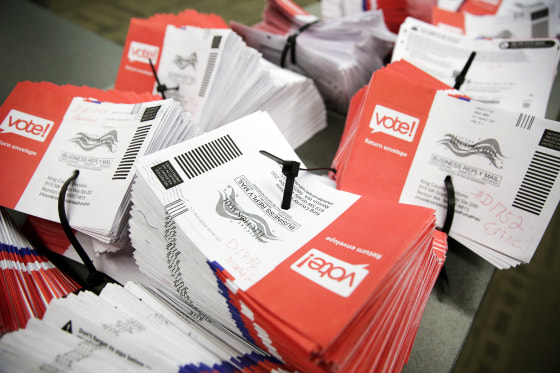Some of the most ardent supporters of voting by mail have a warning: Time is running out to prepare for the November election.
Officials who want to offer far more voters the option of mailing in their ballots are running out of time to make that option a reality, experts warned Wednesday during a livestreamed hearing hosted by the Election Assistance Commission, the federal agency tasked with giving states guidance on how to effectively conduct their elections.
Panelists cautioned that while voting by mail can be a safe and effective option for many Americans, preparations to do so take substantial investments of time and money, made more difficult by the fact that most election officials are working from home because of the coronavirus pandemic.
Scanning machines, ballots and even envelopes can become roadblocks if states do act soon enough.
“I'm one of the biggest advocates for vote-by-mail and absentee voting," said Kim Wyman, the secretary of state of Washington state, which is widely regarded as a leader in transitioning to a full vote-by-mail system.
"And with that said, with the impacts of COVID-19, I am very concerned that with only six months really to implement vote-by-mail or absentee voting in a jurisdiction, that it's going to be a heavy lift," she said. "And if it's not rolled out properly, we will lose public confidence in the results of the election.”
Across the country, state election officials are still figuring out how to best offer voting methods that are accurate, convenient and safe, or at least an approximation of the three. Most states either already offer "no-excuse" absentee ballots by mail or are considering implementing that practice, and expect to have a far bigger surge of mailed-in ballots than in previous elections.
A group of federal agencies, including the EAC and Department of Homeland Security, recently produced an extremely thorough week-by-week advisory timeline for how election security officials should prepare to vote by mail. It advises to take many preliminary steps in April.
The 2020 presidential election is widely expected to see a jump in mailed-in ballots. Voters in Wisconsin, which was widely criticized for holding its primary election on April 7 in the midst of the pandemic, returned over a million mailed-in ballots, about four times the number from the 2016 primary.
Some states require emergency declarations from their governor or acts from their state legislature before they can implement such plans.
Anthony Albence, Delaware's state election director, warned that machines used to process mailed ballots at high speed are often made custom to order.
"We knew we would see a gradual increase in absentee voting but certainly not anticipating this current situation," Albence said. "The lead times for this equipment, we're finding, of course, is significant. A lot of this equipment is built to spec, it's not off-the shelf, especially these high-speed scanners. You need to be getting your orders in now if you want them for the fall.”
Kevin Runbeck, CEO of Runbeck Election Services, an election supply company that provides vote-by-mail services, cautioned that the diversity of ballot styles and sizes across the country means that corresponding custom envelope orders can produce “a chokepoint across the industry."
"And if everybody waits until the last minute, manufacturers can't produce at the same time for everybody,” he said.
"Our biggest challenge right now is decision-making, as stated, needs to be right now," Runbeck said. "We cannot gear up, we cannot build equipment fast enough, if you wait until July to place your orders."

